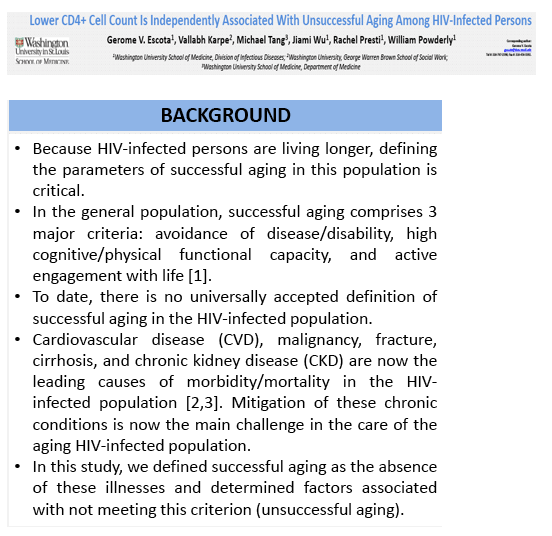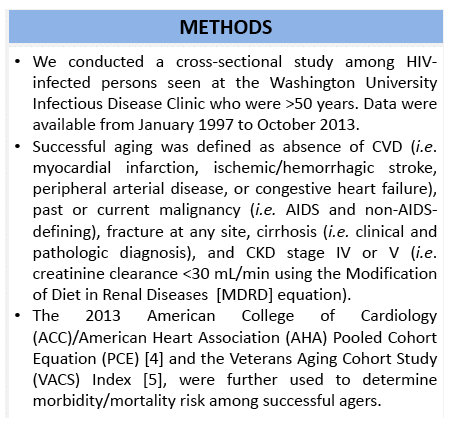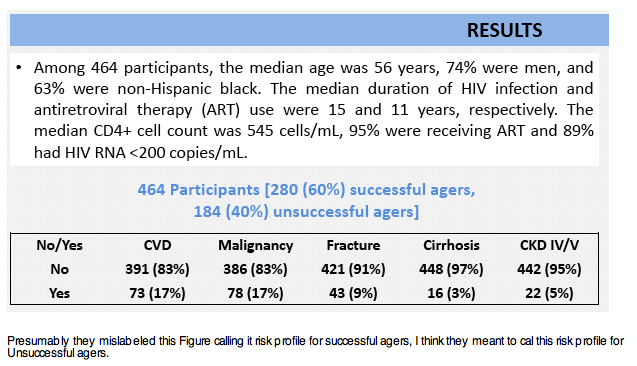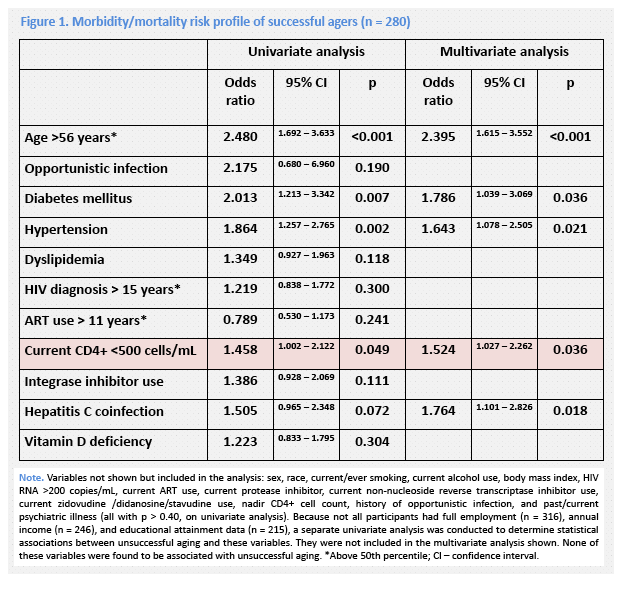 |
 |
 |
| |
Sub-500 Current CD4 Count Linked to Unsuccessful Aging in US Clinic
|
| |
| |
....."These findings, the researchers suggested, stress "the need for closer monitoring and a more comprehensive preventive intervention for the aging HIV-infected population.......Cardiovascular disease (CVD), malignancy, fracture, cirrhosis, and chronic kidney disease (CKD) are now the leading causes of morbidity/mortality in the HIV-infected population [2,3]. Mitigation of these chronic conditions is now the main challenge in the care of the aging HIV-infected population."
IDWeek 2015, October 7-11, San Diego
Mark Mascolini
Current CD4 count below 500 in a US group of older adults with HIV raised chances of unsuccessful aging 50% in a cross-sectional analysis that defined unsuccessful aging as having 1 of 5 serious non-AIDS illnesses [1]. Diabetes, hypertension, and HCV infection--which were not among the 5 defining illnesses--also independently boosted odds of unsuccessful aging.
Despite increasing study of aging in HIV populations, an accepted definition of successful aging has not emerged. Because cardiovascular disease, malignancy, fracture, cirrhosis, and chronic kidney disease (CKD) have become frequent in aging HIV populations, Washington University St. Louis investigators proposed that successful aging with HIV can be defined as absence of all 5 comorbidities. They conducted this study to measure the rate of successful aging in HIV-positive people 50 or older and to identify factors that predict unsuccessful aging.
The analysis involved older HIV-positive adults in care at the Washington University Infectious Disease Clinic between January 1997 and October 2013. The research team defined successful aging as absence of all 5 noted conditions, limiting CKD to stage 4 or 5 (creatinine clearance below 30 mL/min by the MDRD equation). They also calculated the American College of Cardiology/American Heart Association Pooled Cohort Equation (PCE), which estimates 10-year risk of cardiovascular disease, and the Veterans Aging Cohort Study (VACS) index, which estimates 5-year all-cause mortality risk.
The 464 study participants had a median age of 56 years, 74% were men, and 63% were non-Hispanic black. Median duration of HIV infection stood at 15 years and median antiretroviral therapy (ART) duration at 11 years. Almost everyone (95%) was taking ART, 89% had a viral load below 200 copies, and median CD4 count stood at 545.
Among the 464 participants, 280 (60%) ranked as successful agers. Only 17% had cardiovascular disease, 17% malignancy, 9% fracture, 3% cirrhosis, and 5% stage 4 or 5 CKD. Multivariate analysis identified 5 factors that independently raised the odds of unsuccessful aging, at the following adjusted odds ratio (aOR) and 95% confidence intervals:
-- Age over 56: aOR 2.395 (1.615 to 3.552), P < 0.001
-- Diabetes mellitus: aOR 1.786 (1.039 to 3.069), P = 0.036
-- Hypertension: aOR 1.643 (1.078 to 2.505), P = 0.021
-- Current CD4 count below 500: aOR 1.524 (1.027 to 2.262), P = 0.036
-- HCV coinfection: aOR 1.764 (1.101 to 2.826), P = 0.018
Factors that did not affect risk of unsuccessful aging included sex, race, current or former smoking, current alcohol use, body mass index, viral load above 200 copies, and duration of HIV infection or antiretroviral therapy. The researchers performed a separate analysis in people who had information on employment, income, and educational attainment. None of this factors predicted unsuccessful aging.
Among the 280 successful agers, the Washington University team determined that only 28% had a low 10-year risk of cardiovascular disease by PCE, and only 35% had a low 5-year risk of all-cause mortality by the VACS index. These findings, the researchers suggested, stress "the need for closer monitoring and a more comprehensive preventive intervention for the aging HIV-infected population."
The investigators argued that "full immunologic recovery plays an important role in promoting successful aging" in people with HIV, adding that their CD4 finding adds support to recommendations to start ART as early as possible.
Reference
1. Escota G, Karpe V, Wu J, Tang M, Presti R, Powderly W. Lower CD4 cell count is independently associated with unsuccessful physical aging among HIV-infected persons. IDWeek 2015, October 7-11, San Diego. Abstract 1665. https://idsa.confex.com/idsa/2015/webprogram/Paper50633.html




|
| |
|
 |
 |
|
|